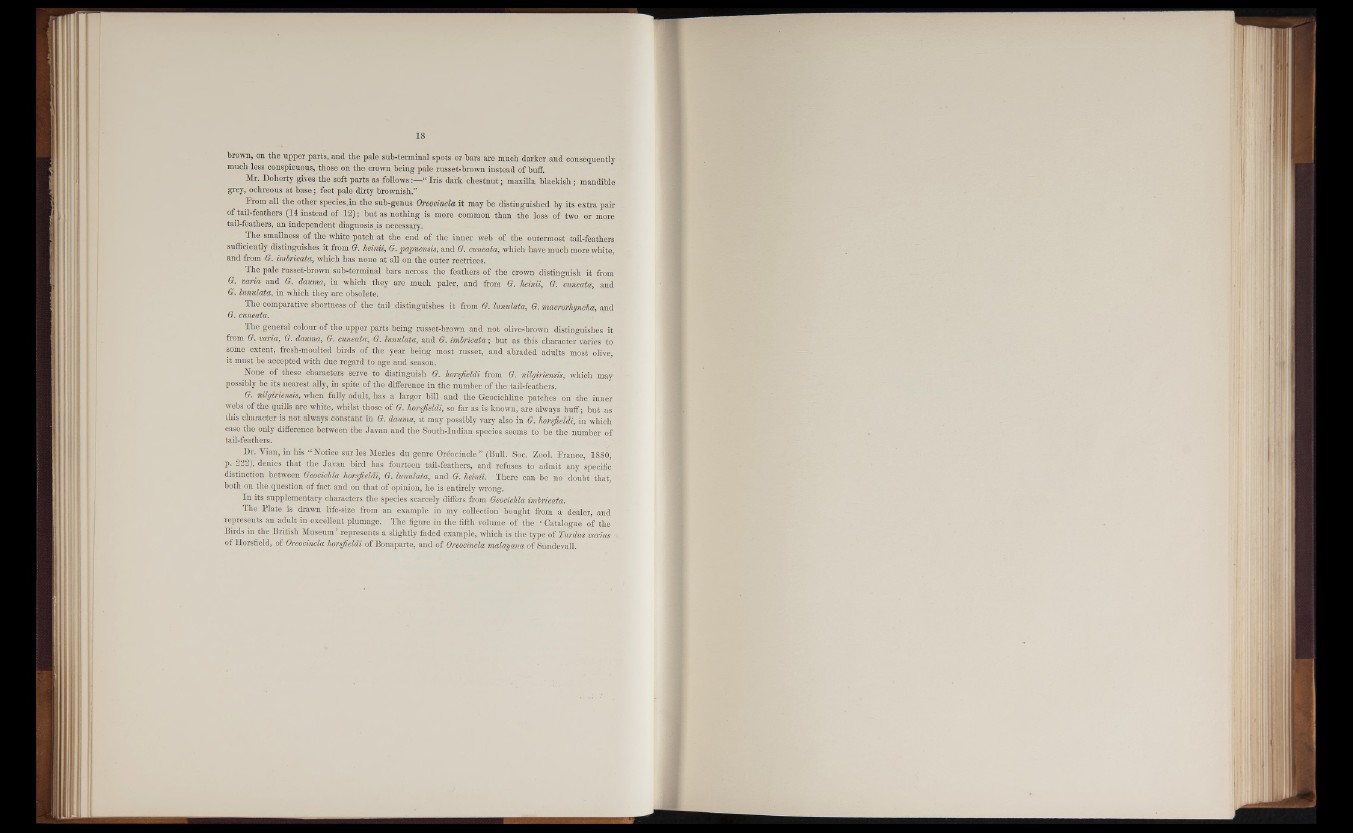
brown, on the upper parts, and the pale sub-terminal spots or bars are much darker and consequently
much less conspicuous, those on the crown being pale russet-brown instead of buff.
Mr. Doherty gives the soft parts a s : f o l l ows “ Iris dark chestnut; maxilla blackish; mandible
grey, ochreous at base; feet pale dirty brownish.”
From all the other species.in the sub-genus Oreocincla it may be distinguished by its extra pair
of tail-feathers (14 instead of 12); but as nothing is more common than the loss of two or more
tail-feathers, an independent diagnosis is necessary.
The smallness of the white patch at the end of the inner web of the outermost tail-feathers
sufficiently distinguishes it from G. heinii, G. papuensis, and G. cuneata, which have much more white,
and from G. imbricata, which has none at all on the outer rectrices.
The pale russet-brown sub-terminal bars across the feathers of the crown distinguish it from
G. varia and G. dauma, in which they are much paler, and from G. heinii, G. cuneata, and
G. lunulata, in which they are obsolete.
The comparative shortness of the tail distinguishes it from G. lunulata, G. macrorhyncha, and
G. cuneata.
The general colour of the upper parts being russet-brown and not olive-brown distinguishes it
from G. varia, G. dauma, G. cuneata, G. lunulata, and G. imbricata; but as this character varies to
some extent, fresh-moulted birds of the year being most russet, and abraded adults most olive,
it must be accepted with due regard to age and season.
None of these characters serve to distinguish G. horsjieldi from G. nilgiriensis, which may
possibly be its nearest ally, in spite of the difference in the number of the tail-feathers.
G. nilgiriensis, when fully adult, has a larger bill and the Geocichline patches on the inner
webs of the quills are white, whilst those of G. horsjieldi, so far as is known, are always buff; but as'
this character is not always constant in G. dauma, it may possibly vary also in G. horsjieldi, in which
case the only difference between the Javan and the South-Indian species seems to be the number of
tail-feathers.
Dr. Vian, in his “ Notice sur les Merles du genre Oreocincle ” (Bull. Soc. Zool. France, 1880,
p. 222), denies that the Javan bird has fourteen tail-feathers, and refuses to admit any specific
distinction between Geocichla horsjieldi, G. lunulata, and G. heinii. There can be n o ' doubt that,
both on the question of fact and on that of opinion, he is entirely wrong.
In its supplementary characters the species scarcely differs from Geocichla imbricata.
The Plate is drawn life-size from an example in my collection bought from a dealer, and
represents an adult in excellent plumage. The figure in the fifth volume of the ‘ Catalogue of the '
Birds in the British Museum f represents a slightly faded example, which is the type of Turdus varius k
of Horsfield, of Oreocincla horsjieldi of Bonaparte, and of Oreocincla malayana. of Sundevall.